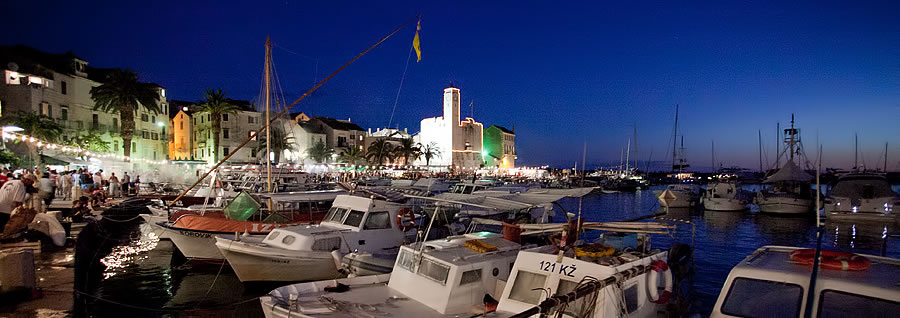

About Komiža
Komiža (Italian: Comisa) is a town, harbour and municipality on the western coast of the island of Vis in the Adriatic sea; population of 1677 residents.
Komiža is located at the foot of the Hum hill (587 m). An average air temperature in January is 8.9 °C. Economy is based on farming, winemaking, fishing and fish processing, seafaring and in recent times on tourism. The fisherman are noted for their Falkuša vessels. On the eastern coast of the bay are large sand and pebble beaches (Kamenica, Gusarica, Nova Posta, Velo Zalo).
Komiža has two roads that connect it with the town of Vis, the only town being connected with Split by ferry line — they are the D117 state road and a county road.
Situated in a deep bay, whose eastern coast abounds with large pebble beaches (Kamenica, Gusarica, Nova Posta, Velo Zalo), Komiza offers excellent visitor opportunities: quality accommodation (hotel, apartments), a number of cultural and historic sites, monasteries and fortresses. It is famous for its fishermen (fishermen from Komiza are also known in San Pedro, California. Many families of Plaquemines Parish, Louisiana have ancestors that came from Komiza, Dalmatia a century and half ago so that fish and other seafood are traditionally served daily. Traditionally the fisherman used the falkuša, a unique wooden sailboat that is tapered narrowly on both ends.
Sports and recreational facilities include three boccia courts, as well as various playgrounds for basketball, handball and football. Water sports and diving are part of the towns summer activities. Komiza is famous for its wines.
The special atmosphere of summer evenings is supplemented by performances of harmony-singing groups (Klape), children’s choirs on the coastal promenade or in one of local restaurants. Exhibitions and other cultural events are regularly organised, especially when the Croatians from the USA are visiting. Komiza natives visit their mother country on a regular basis.
The settlement was first mentioned in the 12th century. The citadel (kaštel) in the port was built in 1585.
In the 13th century, the Benedictines founded the monastery of St. Nicholas, so-called Muster on an elevation above the settlement. The oldest core of the monastery is a one-nave Romanesque church with a semicircular apse from the 13th century.
In the period of the 14th-17th century a large five-nave church was built: its central nave dates back to the beginning of the 16th century and the large Baroque sanctuary to 1652. Two high square towers in Romanesque style have been preserved of the original monastery fortifications; the tower above the church front was converted into a bell tower in 1770.
The church of Our Lady of Gusarica (Lady of Pirates)consists of three one-nave churches of the same size, which are connected with arches in the interior. The oldest of them is the middle church (16th c.), while the side churches date back to the 17th and the 18th centuries. The church features Baroque altars, an organ from 1670 and an outstanding silver relief of Our Lady of the Rosary from the 17th century.
The fortified church of St. Roch (Rocco) was erected in 1763, and the church of Our Lady of the Seven Sorrows (the New Church) dates back to 1756.
The Art Nouveau building of the Community Centre from the beginning of the 20th century is a work by the architect A. Bezic; the Memorial Centre was designed by S. Planic, the author of the reliefs and mosaics is B. Mardesic. The Gallery of Duro Ti-ljak has been open in Komiža since 1966, and since 1984 also the Gallery of Boris Mardesic.
Komiza is located on the island of Vis which is the most distant large island in the Central Dalmatian coast. Vis is centered on 90.3 square kilometers of land. Its widest point spans 17 kilometers and from north to south its maximum length is 8 kilometers. It is approximately 45-55 kilometers from the Dalmatian coastline to the island of Vis. The coastline of Vis measures 76.7 kilometers long and is marked by bays, coves and natural ports.
Komiza experiences warm and temperate winters with warm to hot summers with the landward breeze making it the most moderate climate in the Republic of Croatia. The climate allows for Tropical and Mediterranean vegetation, including palms, carobs, olives, grapes and lemons. The average rainfall is about 750mm per square meter. The island of Vis has more natural sources of drinking water from the natural spring water reservoirs. The island is also home to twelve distinct types of island vegetation. Vis has been marked as one of the ten most environmentally preserved islands in the Mediterranean by the World Organization for Environmental Protection.
Komiža is well known for its close proximity to the island of Bisevo which is visited by 10,000 tourists each year who come to see the unique Blue Cave (Modra Spilja) in the Adriatic Sea. Visitors can also see the St. Nicholas’ Convent monastery from the 13th century, the Kastel (Venetian Tower) in the harbor from the 16th century or Baroque sanctuary from the 16th century.
Komiza is home to Joze Borcic’s international ballet school where students perform ballet, pop, and modern jazz dances during the summer for the town entertainment.
The harbour master is also worth a visit. With his big moustache, he is the local attraction. Some people would even modify their initial plans to enjoy it longer. But that comes at a price, 3600 Kuna, and that’s if you are lucky.
Among the other attractions is the annual celebration of Komiža’s fishing heritage, Ribarska Noč (Fisherman’s Night). The festival features fireworks, many types of traditional food, souvenir shops, ice cream stands, and a children’s kayak